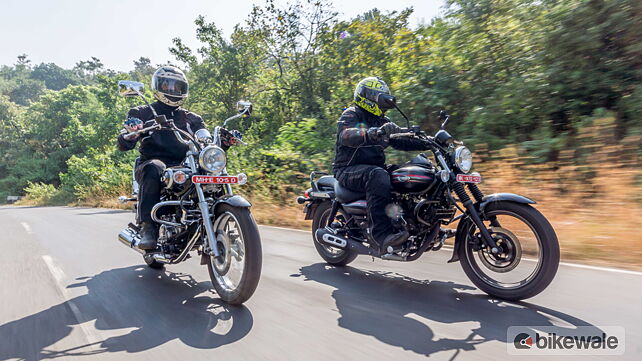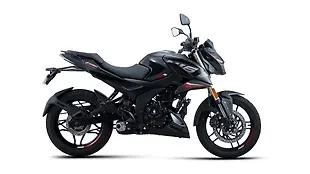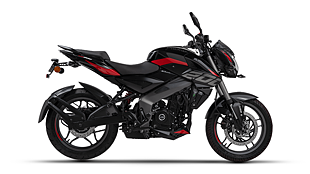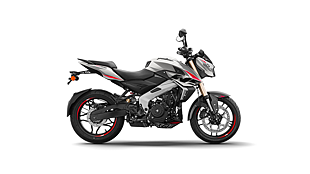What is it?

The new Avenger 220 Cruise and the Avenger 220 Street are examples of Bajaj’s ingenuity. They are here to rejuvenate the long-standing Avenger brand. While the models are similar under the skin, the Avenger 220 Cruise and the Avenger 220 Street are targeted at slightly different sets of buyers.
The former is a take on the authentic old school, highway cruiser with an overdose of chrome all around. From the oil-cooler to the handlebar, from the suspension, spoke wheels, headlamp and the turn indicators to the grab rails, it’s all nice and shiny. The Cruise also sports the quintessential high-rise handlebar and a teardrop fuel tank finished in an elegant grey.
The Avenger 220 Street is more of an urban machine and one that seems to be inspired by the Harley-Davidson Street 750. Compared to the Cruise, the Street gets a blacked-out frame, a flat handlebar, alloy wheels and a matte black paint scheme for the engine. Otherwise, the tank, the body panels, the cycle parts et al are all identical to the Cruise.

How does it ride?

The raked out front, the low seat height and the fat rear tyre are all typical cruiser fare on the Avenger 220 Cruise and Street. Even so, they feel surprisingly agile and manoeuvrable. It takes little effort to get the Avenger to change directions be it in the city or around a set of faster corners. It isn’t the best for corner carving, of course, not with its front end returning little feel via the handlebar, but it isn’t confidence shattering or anything. Moreover, the motorcycles feel surprisingly light to handle.
Even in a straight line, the Avenger feels stable and planted. The brakes work well too. As far as ride quality is concerned, the telescopic front forks have good travel and absorption ability, but the rear end does get a little jumpy and harsh over pronounced undulations and deeper potholes.

What we didn’t like about the Bajaj Avenger 220 Cruise and Street was the engine character. The 19bhp 220cc oil-cooled DTS-i engine was essentially designed for a 220cc street bike. And it shows in its oversquare layout. Even though Bajaj says the torque curve has been revised to suit a cruiser’s character, it doesn’t feel like it on the road. The vibrations start early – at around 70kmph in fifth gear. And by the time the Avenger hits 100kmph these border at the uncomfortable with the vibes being felt at the handlebar, footpegs, tank and even the seat.
Furthermore, the 5-speed gearbox lacks crispness and on our test bike, it was plagued with false neutrals, especially when ridden hard. The good news here is, along with the light clutch and gear ratios that are well set for city use, the Avenger is easy to live with in stop and go conditions.

Anything else I should know?

It can be surprising how a handlebar can make such a big difference. The Avenger 220 Cruise, thanks to its swept back handlebar, feels more like a relaxed cruiser. The Avenger 220 Street, on the other hand, feels more aggressive and sporty right off the mark, courtesy a flatter and lower set handlebar. The new seat is better padded and even the pillion seat isn’t exactly uncomfortable. The backrest cushion on the Avenger 220 Cruise works well too. Another point worth mentioning is the addition of a new LCD display in the instrument console, which integrates the odometer and the tripmeter.
Now, the Avenger 220 Cruise and Avenger 220 Street might look like beautifully finished motorcycles from a distance. But, get close and you will find a few rough edges like the exposed wiring, a few rough welds, some low-rent plastic, and the poorly finished, pseudo brushed-aluminium finish, which we didn’t like at all. The switchgear design looks dated too and could be better finished.

Why should I buy one?

The Avenger 220 Street and the Avenger 220 Cruise are motorcycles targeted at an audience that wishes to enjoy the bliss of owning a cruiser but are held back by a budget. While these motorcycles aren’t perfect there’s no denying their visual appeal. Buy one if you like posing and prefer to take it easy on the road. Both models come with an identical price tag, so the choice of which one to go for is entirely up to you.

Where does it fit in?

As small-capacity cruisers, the only rivals that the Bajaj Avenger 220 Street and Avenger 220 Cruise have are the Mahindra Mojo and the Royal Enfield Thunderbird 350. While the Avenger is a league below its rivals when it comes to outright grunt, opulence and the awe factor, they are far more affordable than the Mojo and the Thunderbird as well. The Rs 84,000 (ex-showroom, Delhi) price tag puts the Avenger 220 Cruise and the Avenger 220 Street well within the reach of many. And of course, who wants to spend even less for a cruiser, there’s always the 150cc Avenger.

Gallery
1/36
Double Tap to Zoom
























![Bajaj Avenger Street 220 [2015-2020] Image Bajaj Avenger Street 220 [2015-2020] Image](https://imgd.aeplcdn.com/272x153/bw/models/bajaj-avenger-street-220.jpg?20191201164636&q=80)























![KTM 390 Adventure X [2025] KTM 390 Adventure X [2025]](https://imgd.aeplcdn.com/272x153/n/cw/ec/190885/390-adventure-x-2025-right-side-view.jpeg?isig=0&q=80)